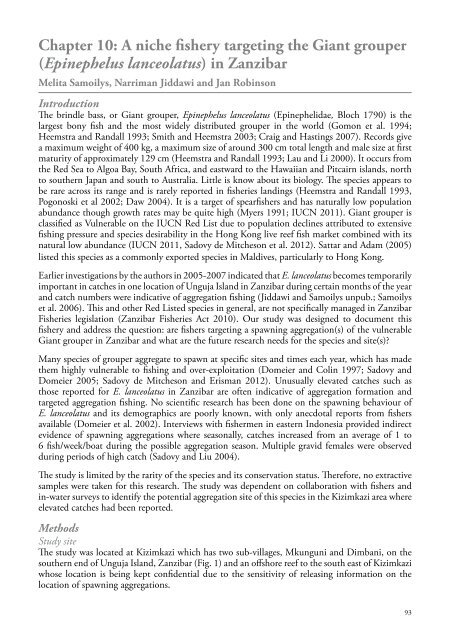WIOMSA-CORDIO spawning book Full Doc 10 oct 13.pdf
WIOMSA-CORDIO spawning book Full Doc 10 oct 13.pdf
WIOMSA-CORDIO spawning book Full Doc 10 oct 13.pdf
Create successful ePaper yourself
Turn your PDF publications into a flip-book with our unique Google optimized e-Paper software.
Chapter <strong>10</strong>: A niche fishery targeting the Giant grouper(Epinephelus lanceolatus) in ZanzibarMelita Samoilys, Narriman Jiddawi and Jan RobinsonIntroductionThe brindle bass, or Giant grouper, Epinephelus lanceolatus (Epinephelidae, Bloch 1790) is thelargest bony fish and the most widely distributed grouper in the world (Gomon et al. 1994;Heemstra and Randall 1993; Smith and Heemstra 2003; Craig and Hastings 2007). Records givea maximum weight of 400 kg, a maximum size of around 300 cm total length and male size at firstmaturity of approximately 129 cm (Heemstra and Randall 1993; Lau and Li 2000). It occurs fromthe Red Sea to Algoa Bay, South Africa, and eastward to the Hawaiian and Pitcairn islands, northto southern Japan and south to Australia. Little is know about its biology. The species appears tobe rare across its range and is rarely reported in fisheries landings (Heemstra and Randall 1993,Pogonoski et al 2002; Daw 2004). It is a target of spearfishers and has naturally low populationabundance though growth rates may be quite high (Myers 1991; IUCN 2011). Giant grouper isclassified as Vulnerable on the IUCN Red List due to population declines attributed to extensivefishing pressure and species desirability in the Hong Kong live reef fish market combined with itsnatural low abundance (IUCN 2011, Sadovy de Mitcheson et al. 2012). Sattar and Adam (2005)listed this species as a commonly exported species in Maldives, particularly to Hong Kong.Earlier investigations by the authors in 2005-2007 indicated that E. lanceolatus becomes temporarilyimportant in catches in one location of Unguja Island in Zanzibar during certain months of the yearand catch numbers were indicative of aggregation fishing (Jiddawi and Samoilys unpub.; Samoilyset al. 2006). This and other Red Listed species in general, are not specifically managed in ZanzibarFisheries legislation (Zanzibar Fisheries Act 20<strong>10</strong>). Our study was designed to document thisfishery and address the question: are fishers targeting a <strong>spawning</strong> aggregation(s) of the vulnerableGiant grouper in Zanzibar and what are the future research needs for the species and site(s)?Many species of grouper aggregate to spawn at specific sites and times each year, which has madethem highly vulnerable to fishing and over-exploitation (Domeier and Colin 1997; Sadovy andDomeier 2005; Sadovy de Mitcheson and Erisman 2012). Unusually elevated catches such asthose reported for E. lanceolatus in Zanzibar are often indicative of aggregation formation andtargeted aggregation fishing. No scientific research has been done on the <strong>spawning</strong> behaviour ofE. lanceolatus and its demographics are poorly known, with only anecdotal reports from fishersavailable (Domeier et al. 2002). Interviews with fishermen in eastern Indonesia provided indirectevidence of <strong>spawning</strong> aggregations where seasonally, catches increased from an average of 1 to6 fish/week/boat during the possible aggregation season. Multiple gravid females were observedduring periods of high catch (Sadovy and Liu 2004).The study is limited by the rarity of the species and its conservation status. Therefore, no extractivesamples were taken for this research. The study was dependent on collaboration with fishers andin-water surveys to identify the potential aggregation site of this species in the Kizimkazi area whereelevated catches had been reported.MethodsStudy siteThe study was located at Kizimkazi which has two sub-villages, Mkunguni and Dimbani, on thesouthern end of Unguja Island, Zanzibar (Fig. 1) and an offshore reef to the south east of Kizimkaziwhose location is being kept confidential due to the sensitivity of releasing information on thelocation of <strong>spawning</strong> aggregations.93


















